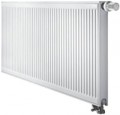Country of origin
The country of origin of the brand.
In most cases, either the homeland of the brand or the location of the manufacturer's headquarters is indicated as the country of origin. Production facilities may well be located in another country. However, it is worth noting here that most of the national stereotypes nowadays are unfounded — the quality of products depends not so much on geography but on the characteristics of the organization of the production process in a particular company. So from this point of view, when choosing, you should focus primarily on the reputation of a particular manufacturer. It makes sense to pay attention to the country of origin of the brand if you fundamentally want (or do not want) to support a company from a certain state.
Nowadays, the production of radiators is mainly carried out by companies from such countries:
England,
Belarus,
Belgium,
Germany,
Holland,
Spain,
Italy,
China,
Norway,
Poland,
Turkey,
Ukraine,
Finland,
Czech Republic.
Heat transfer medium volume
The volume of water or other heating medium required to fill the radiator.
This information is relevant mainly when building an autonomous heating system: it is useful when calculating the total volume of heating medium in the system and related parameters. If the radiator is purchased for use in centralized heating, you can not pay much attention to its internal volume.
Connection size
The diameter of the thread used to connect the radiator to the heating system. Modern radiators use standard sizes — for example,
3/4" or
1/2", less often
1" and
1 1/4". This indicator must match the dimensions of the pipes, couplings and other elements directly used for connection — otherwise, at best, you will need to install adapters, and at worst, the radiator will turn out to be unusable at all.
Usually, the larger the thread diameter, the more powerful the radiator (high power requires intensive circulation of the heating medium and an appropriate throughput at the inlet and outlet).
Heat output
The rated thermal output of the radiator is the amount of heat given off to the air in normal operation.
When choosing this parameter note that the heat output will depend on the temperature difference at the inlet and outlet to the radiator, as well as on the ambient temperature. The greater the temperature difference and the colder it is around, the more intense the heating will be. Therefore, in the specs, it is customary to indicate heat transfer for certain standard conditions. In particular, the designation according to the European standard EN-442 is very popular, which assumes heating medium temperatures of +75 °С and +65 °С at the inlet and outlet, respectively, as well as an air temperature of +20 °С. Real conditions and the actual heat output of the radiator may differ; therefore, when choosing, it is best to choose a model with a certain margin and compensate for excess power with one or another regulator. As for the actual values, in the most modest models, the heat output
does not exceed 750 W, or even
500 W, and in the largest, this figure can reach
3.5 – 4 kW or
more.
The choice for this parameter depends primarily on the size and specs of the heated space. The simplest calculation formula is as follows: at least 100 W of thermal power is required per 1 m2 of area. This formula is relevant for standard r
...esidential/office premises with ceilings of 2.5 – 3 m, without problems with thermal insulation; for more specific conditions, there are more detailed calculation methods, that can be found in special sources.Radiator width
Radiator width.
In modern models, this size can be from
10 cm or even less(in separately sold sections from sectional radiators, see "Type") to
2.5 m or more(in the largest panel products and convectors). At the same time, the design uses mainly standard widths — their list is very extensive, it mainly includes options in increments of 10 cm:
30 cm,
40 cm,
50 cm,
60 cm,
70 cm 80 cm,
90 cm,
100 cm,
110 cm,
120 cm,
130 cm,
140 cm,
150 cm etc. The actual dimensions may differ slightly from the standard, but this difference does not exceed 1 cm: for example, the category "60 cm" includes models with a width of 590 to 610 mm.
The width determines two features of the radiator at once: the size of the space required for installation, as well as heat output. In the first case, everything is quite obvious; we only note that the radiator heater should be placed close to surrounding objects so that it's ok to take a certain margin in width (and if the pipes are c
...onnected sideward, it is worth considering the space required for them). As for heat output, other things being equal, a wider device will have a larger working surface area and a higher heat output (this is also true for heat exchangers in convectors). Thus, modern radiators are traditionally produced not in separate models, but in series of the same type of devices that differ only in size and thermal output.
